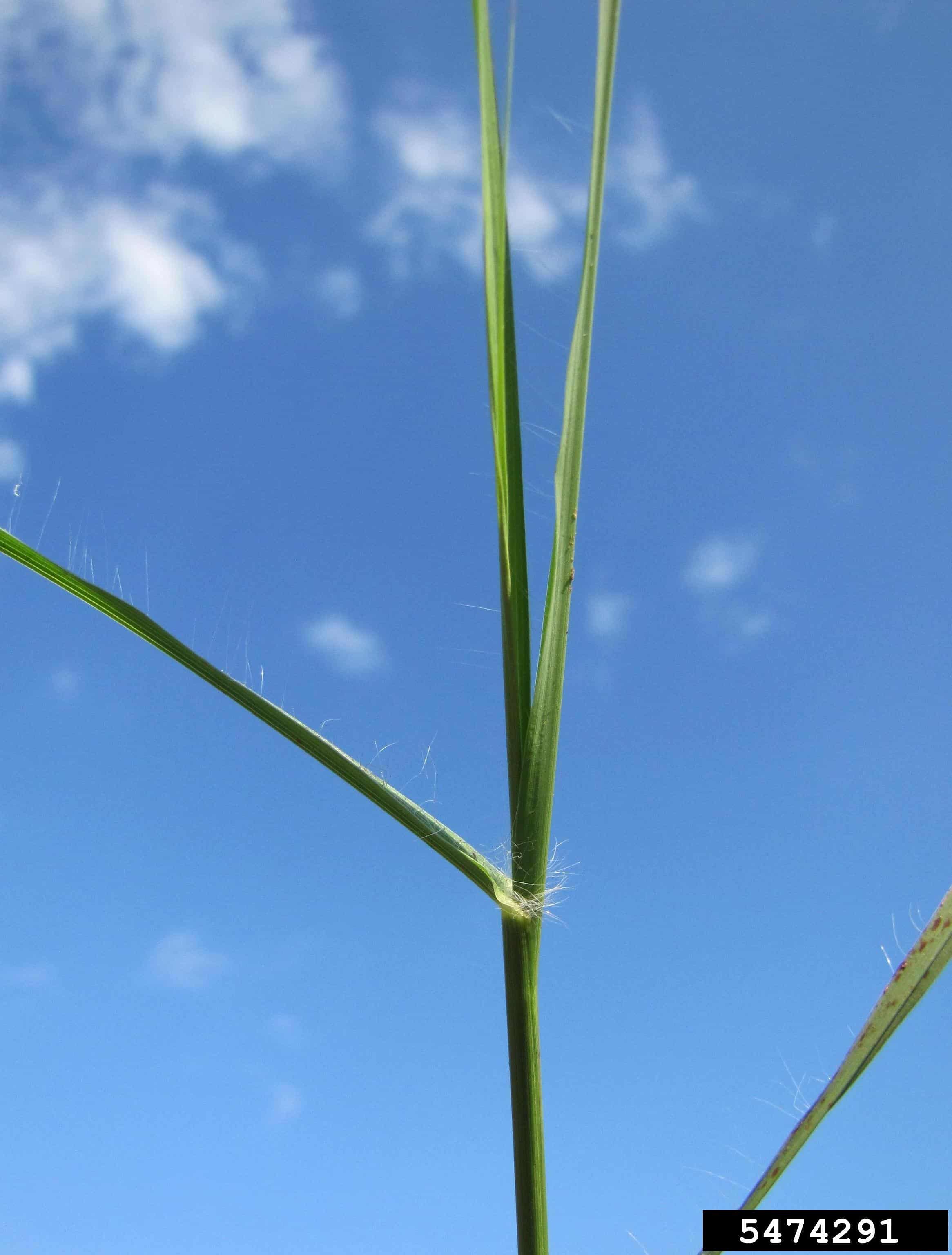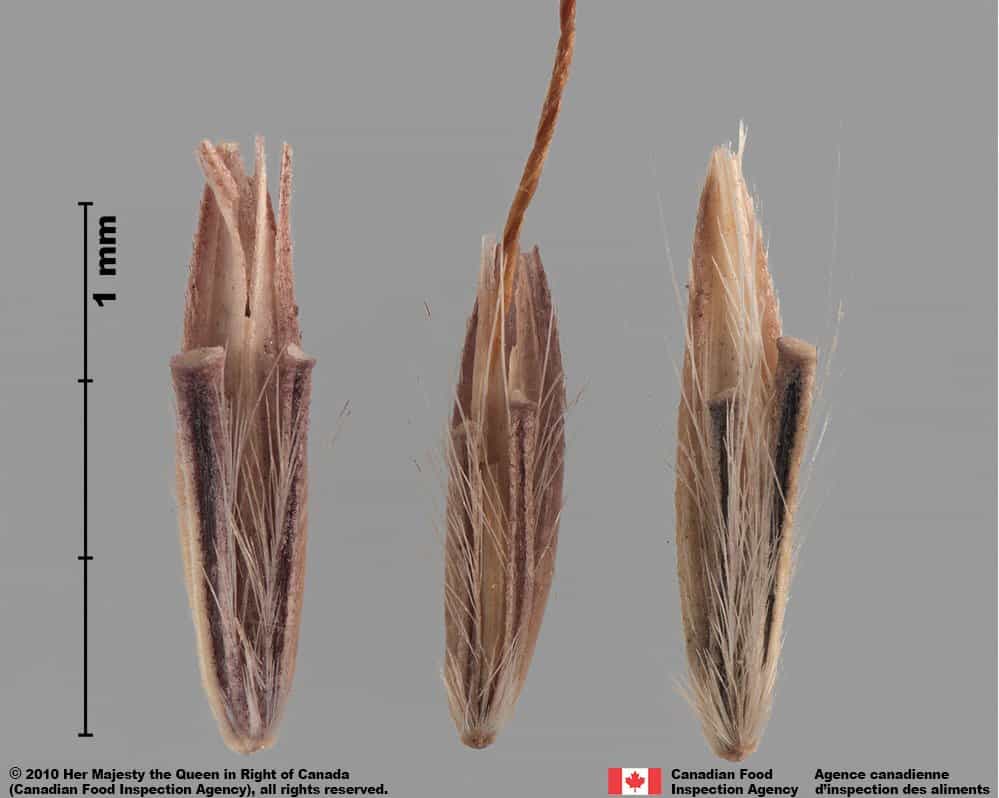Bothriochloa ischaemum
Overview
Aperçu
Regulation :
Remarques Réglementation:
- CFIA Weed Seeds Order - Class 1: Prohibited Noxious Weed Seeds
Regulation Notes:
Prohibited Noxious, Class 1 in the Canadian Weed Seeds Order (2016) under the Seeds Act. All imported and domestic seed must be free of Prohibited Noxious weed seeds.
Distribution :
Répartition :
Native to Asia and southern Europe and introduced in Australia, Mexico, parts of South America, and the United States (Celarier and Harlan 1958 ). Absent from Canada (Brouillet et al. 2010+).
Habitat and Crop Association :
Habitat et Cultures Associées :
Borders of fields, pastures, rangelands, dry stony places, roadsides and waste ground. Often abundant along roads, it tends to spread outwards from roadsides and into new areas (Barkworth et al. 2003).
Economic Use, cultivation area, and Weed Association :
Utilisation économique, zone de culture et association de mauvaises herbes :
Duration of Life Cycle :
Durée du cycle vital:
Perennial
Dispersal Unit Type :
Type d’unité de dispersion :
Spikelet
General Information
RENSEIGNEMENTS GÉNÉRAUX
Bothriochloa ischaemum was introduced into millions of hectares of rangeland in the United States in the early 1900s as a forage crop and soil stabilizer, and plantings continue in marginal rangeland and roadsides (Barkworth et al. 2003; CABI 2021).
Dense stands formed by B. ischaemum tend to eliminate native species, alter the soil microbes and impact wildlife biodiversity and habitat availability (CABI 2021). The plants spread from plantings, infesting surrounding roadsides and native rangeland (Barkworth et al. 2003).
.
Bothriochloa ischaemum infestation (John M. Randall, The Nature Conservancy, Bugwood.org)
Identification
Identification
-
Spikelet
Size
- Spikelet length* : 4.0 – 5.2 mm; width: 0.8 – 1.0 mm
*Note: minimum and maximum of 10 spikelets in a normal range of this species using image measurement (ISMA 2020)
Shape
- Spikelet is long oval shaped, compressed in edge view
Surface Texture
- Spikelet surface is smooth, but the side opposite the stalks has longitudinal ridges
Colour
- Spikelet is dull or shiny light yellow with purple tips
Other Features
- A pair of stalks (a pedicel and rachis segment) edged with long white hairs (length: 1.0 – 3.0 mm; Barkworth et al. 2003) extend 3/4 up the spikelet, each with a central groove more narrow than the edges
- A sterile spikelet may be attached to one of the stalks that is a similar size and shape to the fertile spikelet but without stalks, longitudinally ridged and flattened in edge view with a papery consistency
- Short teeth are along the edges at the narrow end of the spikelet
- The upper, or second glume is keeled with a central ridge with the stalks arranged on either side

Yellow bluestem (Bothriochloa ischaemum) spikelets





-
Floret
Size
- Floret is same size as the spikelet
Shape
- Floret is long oval shaped
Surface Texture
- Floret has a smooth surface
Colour
- Floret is colourless and transparent
Other Features
Lemma awns
- A long awn (length: 9.0 – 17.0 mm; Barkworth et al. 2003) is attached to the lemma, extending beyond the glumes of the spikelet
Other features
- The lemma of the floret is rudimentary, and surrounds the awn
- The palea is as long as the spikelet with hairs along the edges
-
Caryopsis
Size
- Caryopsis length*: 1.5 – 2.0 mm; width: 0.7 – 0.8 mm
*Note: minimum and maximum of 5 caryopses in a normal range of this species using specimen measurement (ISMA 2020)
Shape
- Caryopsis is narrow oval shaped, compressed
Surface Texture
- Caryopsis has a wrinkled surface, with grooved grid reticulation visible under high magnification
Colour
- Caryopsis is dull translucent yellow coloured
Other Features
- Hilum is a brown spot at the embryo end on the opposite side
-
Embryo
Size
- Embryo is a rudimentary size compared to the caryopsis
Shape
- Embryo is oval shaped, lateral position
Endosperm
- Endosperm is hard and translucent whitish coloured
Identification Tips
CONSEILS POUR L’IDENTIFICATION
Many species in the Bothriochloa genus have a similar size, shape and colour. The distinguishing features between the species are found on the paired stalks and the glumes of the spikelet. B. ischaemum can be distinguished by a longitudinally ridged glume with purple tips opposite the stalks. The stalks have hairs generally 1.0 – 3.0 mm long, and a more narrow central groove compared to similar species (Barkworth et al. 2003).

Yellow bluestem (Bothriochloa ischaemum) spikelet, showing teeth along sides of bract





Additional Botany Information
AUTRES RENSEIGNEMENTS BOTANIQUES

Bothriochloa ischaemum (Karan A. Rawlins, University of Georgia, Bugwood.org)



Similar Species
ESPÈCES SEMBLABLES
Similar species are based on a study of seed morphology of various species, and those with similar dispersal units are identified. The study is limited by physical specimen and literature availability at the time of examination, and possibly impacted by the subjectivity of the authors based on their knowledge and experience. Providing similar species information for seed identification is to make users aware of similarities that could possibly result in misidentification.
Bothriochloa bladhii (Retz.) S. T. Blake (Australian bluestem)
B. bladhii spikelets may have a reddish cast, purple streaks, or both on the glumes. The side opposite the stalks of B. bladhii is often dull with short, scattered hairs and occasionally may have a central pit. The stalks have shorter, sparse hairs (length: 0- 1.0 mm; Barkworth et al. 2003) and a darker central groove compared to B. ischaemum.
Bothriochloa laguroides (DC.) Herter (silver beardgrass)
B. laguroides spikelets (length*: 2.9 – 4.4 mm) are generally shorter than B. ischaemum. The glume opposite the stalks lacks ridges, is a uniform colour, occasionally has a central pit, and the teeth appear shorter. The hairs on the stalk are longer (length: 3.0 – 9.0 mm) compared to B. ischaemum (Barkworth et al. 2003) and the central groove is wider.
Note* minimum and maximum of 5 spikelets in a normal range of this species using specimen measurement (ISMA 2020)
Click to select species
Cliquez pour sélectionner les espèces

Bothriochloa bladhii

Bothriochloa laguroides
Comparison Window
Fenêtre de comparaison
MAIN SPECIES
ESPÈCES PRINCIPALES
Bothriochloa ischaemum

Bothriochloa ischaemum
Poaceae
Yellow bluestem (Bothriochloa ischaemum) spikelets
MAIN SPECIES
ESPÈCES PRINCIPALES
Bothriochloa ischaemum

Bothriochloa ischaemum
Poaceae
Yellow bluestem (Bothriochloa ischaemum) spikelets
MAIN SPECIES
ESPÈCES PRINCIPALES
Bothriochloa ischaemum

Bothriochloa ischaemum
Poaceae
Yellow bluestem (Bothriochloa ischaemum) spikelet, inner side
MAIN SPECIES
ESPÈCES PRINCIPALES
Bothriochloa ischaemum

Bothriochloa ischaemum
Poaceae
Yellow bluestem (Bothriochloa ischaemum) spikelet, outer side
MAIN SPECIES
ESPÈCES PRINCIPALES
Bothriochloa ischaemum

Bothriochloa ischaemum
Poaceae
Yellow bluestem (Bothriochloa ischaemum) spikelet, showing teeth along sides of bract
SIMILAR SPECIES
ESPÈCES SEMBLABLES
Bothriochloa bladhii

Bothriochloa bladhii
Poaceae
Australian bluestem (Bothriochloa bladhii) spikelets
SIMILAR SPECIES
ESPÈCES SEMBLABLES
Bothriochloa bladhii

Bothriochloa bladhii
Poaceae
Australian bluestem (Bothriochloa bladhii) spikelets
SIMILAR SPECIES
ESPÈCES SEMBLABLES
Bothriochloa bladhii

Bothriochloa bladhii
Poaceae
Australian bluestem (Bothriochloa bladhii) spikelet
SIMILAR SPECIES
ESPÈCES SEMBLABLES
Bothriochloa bladhii

Bothriochloa bladhii
Poaceae
Australian bluestem (Bothriochloa bladhii) spikelet
SIMILAR SPECIES
ESPÈCES SEMBLABLES
Bothriochloa bladhii

Bothriochloa bladhii
Poaceae
Australian bluestem (Bothriochloa bladhii) spikelet
SIMILAR SPECIES
ESPÈCES SEMBLABLES
Bothriochloa bladhii

Bothriochloa bladhii
Poaceae
Australian bluestem (Bothriochloa bladhii) spikelet
SIMILAR SPECIES
ESPÈCES SEMBLABLES
Bothriochloa bladhii

Bothriochloa bladhii
Poaceae
Bothriochloa bladhii caryopses
Need ID Help?
Besoin d’aide pour l’identification?
Reference(s)
Référence(s)
Barkworth, M. E., K. M. Capels, S. Long, and M.B. Piep, (eds.) 2003. Flora of North America Volume 25. Magnoliophyta: Commelinidae (in part): Poaceae, part 2. Oxford University Press, New York, New York.
Brouillet, L., Coursol, F., Meades, S.J., Favreau, M., Anions, M., Bélisle, P. and Desmet, P. 2010+. VASCAN, the database of vascular plants of Canada. http://data.canadensys.net/vascan/ Accessed May 30, 2016.
Centre for Agriculture and Bioscience International (CABI). 2021. Invasive Species Compendium, CAB International, Wallingford, UK. https://www.cabidigitallibrary.org/journal/cabicompendium Accessed March 04, 2021.
Celarier, R.P and Harlan, J.R. 1958. The cytogeography of the Bothriochloa ischaemum complex. Gramineae. I. Taxonomy, and Geographic Distribution. Botanical Journal of the Linnean Society 755-760.
Flora of North America (FNA) Editorial Committee, eds. 1993+. Flora of North America North of Mexico [Online]. 22+ vols. New York and Oxford. Accessed December 29, 2022.
Global Biodiversity Information Facility (GBIF) Secretariat. 2022. https://doi.org/10.15468/39omei Accessed via https://www.gbif.org/species/2704102 Accessed December 29, 2022.
Government of Canada (GC). 2016. Canadian Weed Seeds Order. https://laws-lois.justice.gc.ca/eng/regulations/SOR-2016-93/page-2.html (English) https://laws-lois.justice.gc.ca/fra/reglements/DORS-2016-93/page-2.html (French)
Integrated Taxonomic Information System (ITIS). 2021. https://www.itis.gov/ Accessed March 04, 2021
International Seed Morphology Association (ISMA). 2020. Method for Seed Size Measurement. Version 1.0. ISMA Publication Guide. https://www.idseed.org/authors/details/method_for_seed_size_measurement.html




